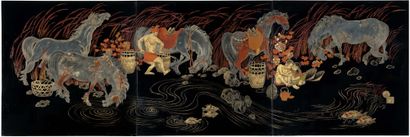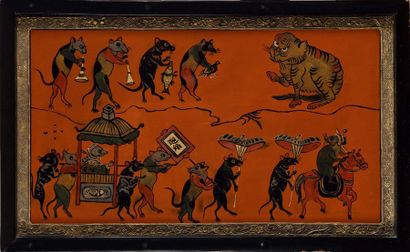Nguyen Khang (1912-1989)Nha Rong Wharf circa 1960s signed lacquer, pigment and gold foil on wood 60 by 120 cm. (total two panels with their mount) 23 1/2 by 47 1/4 in.FootnotesProvenance Sotheby's Singapore, 16 May 1998, lot 107 Private collection, Singapore 阮康 龍屋港 約1960年代作 簽名:NG Khang(左下) 漆木 金箔 來源 新加坡,蘇富比,1998年5月16日,拍品編號107 新加坡私人收藏 Born in 1912 in Hanoi, Nguyen Khang is regarded as one of the pioneers of Vietnamese lacquer art. Along with fellow artists Pham Hau (1903-1994), Nguyen Gia Tri (1906-1993) and Tran Van Can (1910-1994), he played a critical role in the development of lacquer painting as a distinct style of fine art that was both modern and national in Vietnam. Between 1930 and 1935, Nguyen Khang studied at the École des Beaux-Arts de l'Indochine (EBAI) led by the French painters Victor Tardieu (1870-1937) and Joseph Inguimberty (1896-1971), who encouraged EBAI students to explore further the potential of lacquer techniques in two-dimensional plane space. Although Asian countries have long aesthetic traditions of lacquer work, it is only in Vietnam where lacquer has transformed into a dynamic painting medium that embodies Vietnam's contested history of nation-building from the 1930s onwards. Nguyen Khang's lacquer paintings matured with great rapidity in the late 1930s through the early 1940s when he participated in and received awards from several important international exhibitions. The style and subject matter of Nguyen Khang's early work reveal his search for new symbols and identity of Vietnamese culture. A devoted nationalist, Nguyen Khang supported the cause of the anti-colonial struggle and therefore joined the August Revolution in 1945 and the Anti-French Resistance War in 1946. His ties to the communist resistance movement compelled him to integrate the notions of nation (dan toc), national character (tinh dan toc) and national culture (van hoa dan toc) advocated by then-president Ho Chi Minh into his lacquer art. Nha Rong Wharf, imbued with national identity and otherwise shrouded in symbolism, depicts an imaginary scene of Ben Nha Rong (Dragon House Wharf) located at the junction of the Ben Nghe Canal and the Saigon River. The Dragon House is shown on the upper right side of the painting—it was a prominent premises built by the French authority between 1862 and 1863 to be the seat of the shipping company Messageries Maritimes. Today, this site is celebrated as the launching point for the young Nguyen Tat Thanh (later known as Ho Chi Minh)'s quest for national salvation; moreover, it has gone on to serve as a memorial site and a museum honouring this Vietnamese national hero. In an intriguing way, this lacquer painting treats Nha Rong Wharf as an aniconic symbol of Ho Chi Minh and seems to commemorate the historic moment of his departure from Nha Rong in 1911 for a thirty year-long journey around the world to save the country. It is noteworthy that Nguyen Khang's Uncle Ho Visiting the Village (1958), also a lacquer painting dedicated to Ho Chi Minh, belongs in the permanent collection of Japan's Fukuoka Asian Art Museum.1 A characteristic feature of Nguyen Khang's lacquer work, which can be seen in this painting, is the sophisticated technique of sprinkling metal powders such as gold and silver on the surface of the artwork using a sieve for equal distribution. This technique allows the sombre black board to shine through, achieving a soft, subtle shimmer effect and creating a sense of depth. Khang's preference for making images with a black background suggests an influence of Japanese lacquerware style, particularly the Rimpa School and its revival models in the late 19th century and early 20th century.2 Additionally, the iconographic influence of Vietnam's Dong Ho woodblock prints, which are created for the masses and often depict subaltern subject matter like folktales and villagers' everyday lives, is also evident in Nguyen Khang's work. Nha Rong Wharf is a fascinating glimpse of various aspects of
Nguyen Khang (1912-1989)Nha Rong Wharf circa 1960s signed lacquer, pigment and gold foil on wood 60 by 120 cm. (total two panels with their mount) 23 1/2 by 47 1/4 in.FootnotesProvenance Sotheby's Singapore, 16 May 1998, lot 107 Private collection, Singapore 阮康 龍屋港 約1960年代作 簽名:NG Khang(左下) 漆木 金箔 來源 新加坡,蘇富比,1998年5月16日,拍品編號107 新加坡私人收藏 Born in 1912 in Hanoi, Nguyen Khang is regarded as one of the pioneers of Vietnamese lacquer art. Along with fellow artists Pham Hau (1903-1994), Nguyen Gia Tri (1906-1993) and Tran Van Can (1910-1994), he played a critical role in the development of lacquer painting as a distinct style of fine art that was both modern and national in Vietnam. Between 1930 and 1935, Nguyen Khang studied at the École des Beaux-Arts de l'Indochine (EBAI) led by the French painters Victor Tardieu (1870-1937) and Joseph Inguimberty (1896-1971), who encouraged EBAI students to explore further the potential of lacquer techniques in two-dimensional plane space. Although Asian countries have long aesthetic traditions of lacquer work, it is only in Vietnam where lacquer has transformed into a dynamic painting medium that embodies Vietnam's contested history of nation-building from the 1930s onwards. Nguyen Khang's lacquer paintings matured with great rapidity in the late 1930s through the early 1940s when he participated in and received awards from several important international exhibitions. The style and subject matter of Nguyen Khang's early work reveal his search for new symbols and identity of Vietnamese culture. A devoted nationalist, Nguyen Khang supported the cause of the anti-colonial struggle and therefore joined the August Revolution in 1945 and the Anti-French Resistance War in 1946. His ties to the communist resistance movement compelled him to integrate the notions of nation (dan toc), national character (tinh dan toc) and national culture (van hoa dan toc) advocated by then-president Ho Chi Minh into his lacquer art. Nha Rong Wharf, imbued with national identity and otherwise shrouded in symbolism, depicts an imaginary scene of Ben Nha Rong (Dragon House Wharf) located at the junction of the Ben Nghe Canal and the Saigon River. The Dragon House is shown on the upper right side of the painting—it was a prominent premises built by the French authority between 1862 and 1863 to be the seat of the shipping company Messageries Maritimes. Today, this site is celebrated as the launching point for the young Nguyen Tat Thanh (later known as Ho Chi Minh)'s quest for national salvation; moreover, it has gone on to serve as a memorial site and a museum honouring this Vietnamese national hero. In an intriguing way, this lacquer painting treats Nha Rong Wharf as an aniconic symbol of Ho Chi Minh and seems to commemorate the historic moment of his departure from Nha Rong in 1911 for a thirty year-long journey around the world to save the country. It is noteworthy that Nguyen Khang's Uncle Ho Visiting the Village (1958), also a lacquer painting dedicated to Ho Chi Minh, belongs in the permanent collection of Japan's Fukuoka Asian Art Museum.1 A characteristic feature of Nguyen Khang's lacquer work, which can be seen in this painting, is the sophisticated technique of sprinkling metal powders such as gold and silver on the surface of the artwork using a sieve for equal distribution. This technique allows the sombre black board to shine through, achieving a soft, subtle shimmer effect and creating a sense of depth. Khang's preference for making images with a black background suggests an influence of Japanese lacquerware style, particularly the Rimpa School and its revival models in the late 19th century and early 20th century.2 Additionally, the iconographic influence of Vietnam's Dong Ho woodblock prints, which are created for the masses and often depict subaltern subject matter like folktales and villagers' everyday lives, is also evident in Nguyen Khang's work. Nha Rong Wharf is a fascinating glimpse of various aspects of

.jpg)






.jpg)


Testen Sie LotSearch und seine Premium-Features 7 Tage - ohne Kosten!
Lassen Sie sich automatisch über neue Objekte in kommenden Auktionen benachrichtigen.
Suchauftrag anlegen